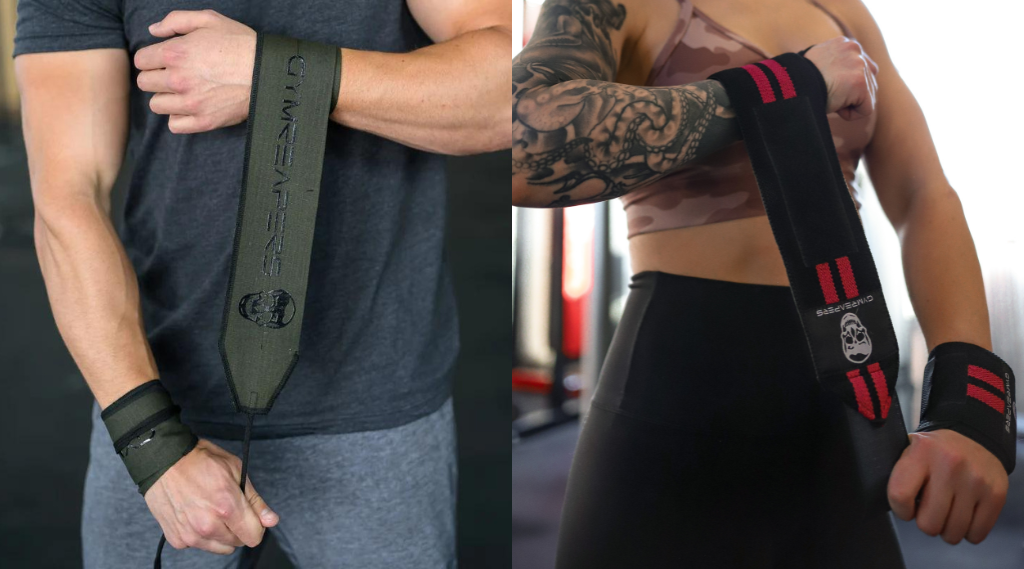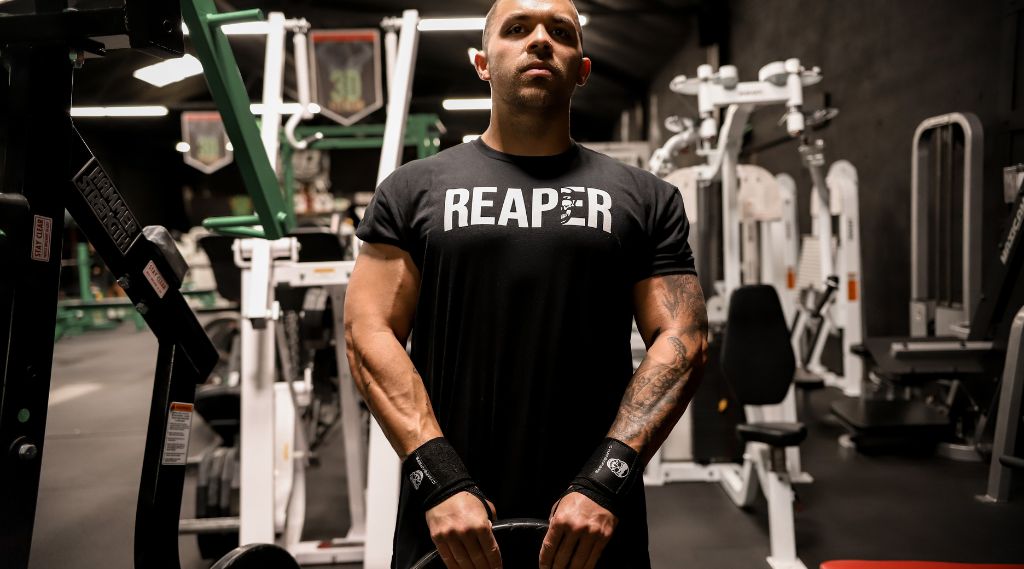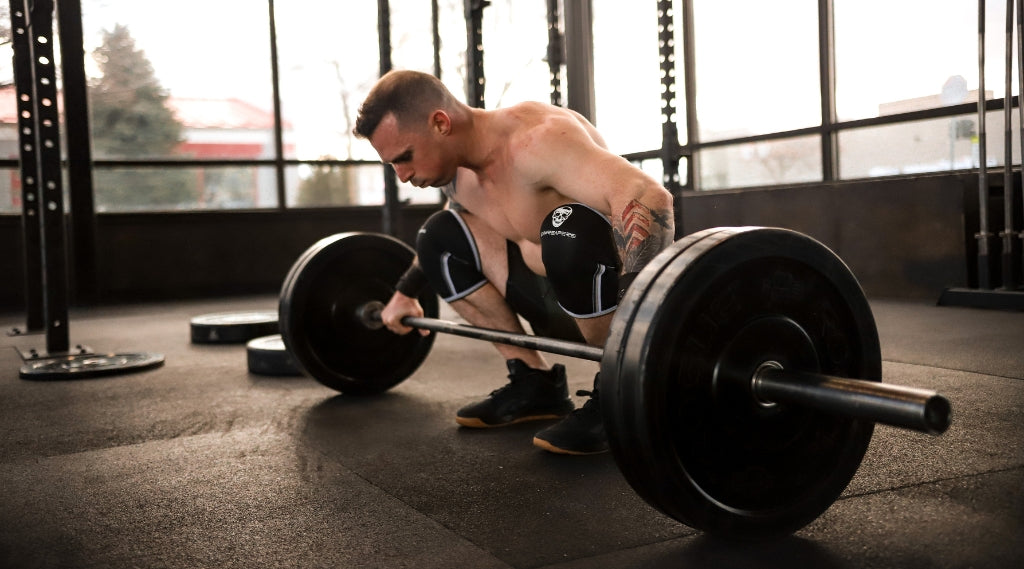The best wrist wraps for CrossFit offer enough support for heavy lifts but also allow you to have varying degrees of support to adjust for movements that also require more wrist mobility. Adjustable velcro or cotton cloth wraps are two of the most common types used in CrossFit.
To make the most of wrist wraps for CrossFit it’s important to pick the right pair and use them correctly, so I’ll explain how to determine the best wrist wraps and answer common questions lifters have about when and how to wear wrist wraps when doing CrossFit.
Why It’s Important To Wear Wrist Wraps During Crossfit

Wearing wrist wraps for CrossFit provides support for a variety of lifts and movements involving the wrist joint. Wrist injuries are also very common when lifting, so wearing wrist wraps can help increase injury prevention while also boosting performance.
The benefits of wearing wrist wraps for CrossFit include:
Joint Support
Wrist wraps help to support the wrist joint so that it does not move around excessively under load. This support can help increase joint stability, injury prevention, and even performance.
While performing movements like overhead pressing, thrusters, handstand push ups, and snatches (just to list a few), joint support is key for overall health and performance. Failure to support the wrist joint under heavy loads and/or high reps can result in discomfort, injury, or poor performance.
Compression
Wrist wraps provide compression to the joint and area around the wrist, which can help increase joint stability and blood flow to the surrounding tissues (ligaments, tendons, and muscles).
With light compression around the joint, you can keep the wrist joints mobile, yet still get the support you need for more demanding tasks like lifting objects overhead.
Without wrist wraps, you may find your wrists are too mobile and lack stability, which can increase the risk of injury, especially under heavy repetitive loads.
Pain Reduction
Wrist wraps also have the potential to decrease aches and pains that you may experience from CrossFit by providing the joint with stability and warmth (especially if you’re leaving the wraps on for your entire workout).
That said, if you have wrist pain during any CrossFit exercise, you should first review your form and determine if that is the main cause, as wrist wraps should never be worn to improve bad form. Additionally, if you suspect you have a wrist injury, you should seek medical attention.
Stability
Having a stable joint will not only ensure lower risks of injury but also can help improve performance and comfort when training.
In CrossFit, this may mean you feel stronger in the overhead position, or your wrists are not excessively bent backward in the front squat (which can relate to injury and decrease your front squat strength).
Wearing wrist wraps can help further reinforce good technique and positions while lifting and training, and can help you maintain stability under heavy loads of higher rep workouts when you are training to failure.
Injury Prevention
Most wrist injuries in CrossFit either happen after the wrist is abruptly hyperextended (bent back excessively) under load or over a period of time when the connective tissues and joint take too much wear and tear (due to poor wrist stability or form).
Exercises like front squats, jerks, or anything overhead can create extra stress on the wrist joint and connective tissues. By ensuring proper technique and wearing wrist wraps, you can reduce your risk of injury.
It is important to note that wrist wraps are not to replace improvements in technique, however, they can certainly boost injury prevention when you are already using good technique.
Enhancing Performance
When you have a stable joint you can produce higher amounts of force out of that joint safely. Therefore, wrist wraps may help you lift heavier loads or do a few more reps than you could without them, especially if your wrist stability is something that usually limits you.
For example, many lifters miss snatches in the overhead position despite good technique simply because their wrist stability is poor (or just fatigued during higher rep workouts). Wrist wraps can help improve their stability and result in more successful lifts.
How To Find The Best Wrist Wraps For Crossfit

Materials
When looking at a wrist wrap for CrossFit, there are two materials that you can choose from.
Elastic / Polyester Blend Wrist Wrap
The first is an elastic and polyester blend, which offers good support and can be easily adjusted to change the level of support you need depending on the movement you’re performing.
The elastic component of the wrist wrap will allow you to really tighten up the stiffness while still being able to maintain some level of joint mobility.
For example, you’ll want a tighter, more compressive fit when performing pressing movements but a more relaxed fit in movements like the clean or front squat which requires more wrist mobility.
The only downside to this blend of materials is that some people find them to be uncomfortable when worn for longer periods.
Cotton Wrist Wraps
The other main wrist wrap material type is cotton, which also offers an adjustable level of stiffness and can easily be worn for many CrossFit movements. These wraps can be tightened up and provide good levels of support, but not as much support as the elastic/polyester blend wraps.
Cotton wrist wraps can easily be loosened and worn for extended periods on movements like double unders, handstand walks, and toes to bar.
The cotton material tends to be more comfortable than the elastic/polyester blend when needed to be worn for longer periods.
However if you need wraps just for heavy lifts or are taking them on and off between exercises, then comfort shouldn't be the primary factor when selecting a material.
Length
Most lifters will find that an 18” wrap will offer enough material to get varying levels of support without having too much excess material that the wraps are heavy or get in the way.
If you are only wearing wraps for heavier lifts and plan to take them off between uses, the 18” elastic blend wraps would be the way to go.
If you are looking for wraps that you can keep on throughout a workout and you don’t need as much support, you could try the 36” cotton wraps. While these are twice the length of the elastic ones, they are much lighter and more compact when worn on the wrist.
Closure

The closures on wrist wraps are either made from velcro or a cotton string that is folded underneath itself to allow you to twist and adjust the stiffness of the wrap.
Both are easily adjustable and secure and can provide you with high amounts of stiffness and stability without sacrificing too much comfort.
The velcro is easier to get a repeatable level of stiffness, whereas the cotton string may take a bit longer to get the level of stiffness since you need to wrap the string around the wrist a few times, fold it underneath itself, and then twist the material.
All in all, both closure systems are fairly easy to operate and provide you with a quick way to adjust the level of support you need.
Durability
Both materials discussed above are very durable, but generally, wrist wraps that are made from the elastic blend have a velcro-style closure, which over the long term may give out before the string closure of cotton wrist wraps.
Along with the durability of the style of closure, you should also consider the quality of the stitching.
Lower-quality wrist wraps will have lower-quality stitching which is easily degraded and can cause your wrist wraps to come apart. Higher-quality wrist wraps will have reinforced stitching that you can count on.
Thumb Loop
A thumb loop on a wrist wrap allows you to properly position the wrap every time you wear it, while also helping you get an even more secure fit.
Wrist wraps made from the elastic blend material generally come with a thumb loop to help you get the proper placement of the wrap as you begin to tighten it down.
Wrist wraps made from cotton generally do not have the thumb loop, as the closure style (string) requires that the material move freely around the wrist, as that is the way you adjust the wrap tightness.
This may not be a huge issue for everyone; however, some lifters may find the material starts to loosen the more it moves around during workouts (requiring a quick, yet sometimes irritating need to tighten the wrap up again).
Warranty
Many companies make wrist wraps, however, very few offer a warranty for their products. At Gymreapers, we stand by our products and gear and offer a lifetime replacement guarantee. We will replace your wrist wraps (and all other gear) at no additional cost.
CrossFit Wrist Wrap Recommendations
My top recommendations for CrossFit wrist wraps are:
Elastic Weightlifting Wrist Wraps

These 18” wrist wraps are made of elastic and polyester, which help them provide great levels of wrist support while also giving you a comfortable and adjustable fit.
These are best used with heavier training or in workouts where you need higher amounts of stability. You can quickly adjust these during a workout, however, these are best worn when taking them off between sets.
Adjustable Cotton Strength Wrist Wraps

The 36” adjustable strength wrist wraps are made of cotton and are durable and comfortable wrist wraps that are ideal for longer WODs, gymnastics, and even weightlifting movements that require both stability and flexibility of the wrists.
When To Wear Wrist Wraps For CrossFit
You should try to wear wrist wraps when you need added wrist support and protection, such as during heavier lift attempts (above 75% of your 1 rep max) or when you are training closure to failure with varying loads.
Most lifters will choose to wear wrist wraps on movements where the wrist tends to lose stability. These are typically in the front squat, overhead pressing movement (thrusters, push presses, jerks, overhead presses), snatches, and handstands.
Some lifters will also wear them during gymnastic movements like toes to bars and even wear them loosely on double unders.
However, wearing them all the time can decrease your natural ability to stabilize your wrists, and can create an over-dependence on them in training.
I recommend warming up without wrist wraps and then putting them on when you get to heavier loads. You can also wear them for lighter, less intense WODs and then put them on as you push harder.
When Not To Wear Wrist Wraps For CrossFit
You should avoid wearing wrist wraps when you are not training with heavier loads or when you are not training close to failure. It can be tempting to keep them on for all movements, however, you want to make sure that your body is able to provide adequate stability without wrist wraps as you also need good joint support outside of the gym too.
FAQ
When Should You Start Wearing Wrist Wraps?
If you’re a beginner, it is not recommended to start wearing wrist wraps, even with heavier loads, as you should first develop the ability to lift without them. Most lifters should first learn proper technique and have been training consistently for at least 1 year before relying on wrist wraps for additional support.
Are Wrist Wraps Good For New Lifters In Crossfit?
No, wrist wraps are not good for new lifters to CrossFit as they can mask poor form and prevent you from developing the necessary wrist stability your body should have before wearing wraps. Too often new lifters put on wrist wraps without building wrist strength and end up having injuries down the road.
Do I Need Stiff Or Flexible Wrist Wraps For Crossfit?
If you are wanting to wear wrist wraps for heavier lifts like cleans, snatches, jerks, and front squats, then you need a stiffer wrap that you can take on and off. If you need a wrist wrap for general support and lighter-weight WODs (thruster, toes to bar, double unders), then a flexible wrap may be best.
What Material Is Best For Wrist Wraps?
The best material is the one that fits your needs. Elastic polyester blend wraps offer greater support which is needed for Olympic lifts and strength movements, however cotton wraps (while they can also be worn for those) offer less support but more flexibility, which can be good for lighter-weight WODs and gymnastics.













Leave a comment
All comments are moderated before being published.
This site is protected by hCaptcha and the hCaptcha Privacy Policy and Terms of Service apply.